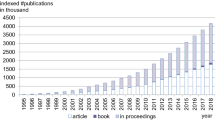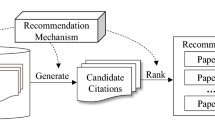Abstract
Authors and publishers use different metrics at various levels to estimate the impact of produced research, including the journal-level impact factor, the number of citations at an article-level and the H-index at an author-level. In this paper, we propose an approach to measure the Article Citation Impact (ACI) that will enable idenGEAtification of the impact of articles at their extended nearby citation network. We combine an article’s content with its bibliometrics to evaluate the citation impact of articles in their surrounding citation network. Using the article metadata, we calculate the semantic similarity between two articles in the extended network. The articles’ similarity and bibliometric scores are then used to assess the impact of the article among their extended nearby citation network. In our empirical studies, we use two datasets to validate the efficiency of our approach to evaluate the impact of articles on improving article recommendation processes. The experimental results highlight the effectiveness of the proposed approach to optimize the overall recommendation quality, compared to other baseline approaches.







Similar content being viewed by others
References
Vogel R (2012) The Visible Colleges of Management and Organization Studies: A Bibliometric Analysis of Academic Journals. Organ Stud 33:1015–1043. https://doi.org/10.1177/0170840612448028
Bornmann L, Marx W (2015) Methods for the generation of normalized citation impact scores in bibliometrics: Which method best reflects the judgements of experts? J Inf Secur 9:408–418. https://doi.org/10.1016/j.joi.2015.01.006
Musau F, Wang G, Abdullahi MB (2014) Group formation with neighbor similarity trust in P2P E-commerce. Peer-to-Peer Networking & Applications 7:295–310. https://doi.org/10.1007/s12083-011-0116-4
Sula CA, Miller M (2014) Citations, contexts, and humanistic discourse: Toward automatic extraction and classification. Lit Ling Comput 29:452–464. https://doi.org/10.1093/llc/fqu019
Alshareef A, Alhamid M, El Saddik A (2018) Article Impact Value for Nearby Citation Network Analysis. In: IEEE International Conference on Big Data and Smart Computing. IEEE, Shanghai, China
Todeschini R, Baccini A (2016) Handbook of Bibliometric Indicators: Quantitative Tools for Studying and Evaluating Research
van Wesel M (2016) Evaluation by Citation: Trends in Publication Behavior, Evaluation Criteria, and the Strive for High Impact Publications. Sci Eng Ethics 22:199–225. https://doi.org/10.1007/s11948-015-9638-0
Waltman L (2016) A review of the literature on citation impact indicators. J Inf Secur 10:365–391
Moed HFH (2006) Citation analysis in research evaluation
Thelwall M, Fairclough R (2015) The influence of time and discipline on the magnitude of correlations between citation counts and quality scores. J Inf Secur 9:529–541. https://doi.org/10.1016/j.joi.2015.05.006
Calma A, Davies M (2013) Studies in Higher Education 1976 – 2013 : a retrospective using citation network analysis. Stud High Educ 40:4–21. https://doi.org/10.1080/03075079.2014.977858
Melero R (2015) Altmetrics --- A complement to conventional metrics. Biochem Med 25:152–160. https://doi.org/10.11613/BM.2015.016
Gipp B, Meuschke N (2015) CITREC : An Evaluation Framework for Citation-Based Similarity Measures based on TREC Genomics and PubMed Central. Proc iConference 2015 24–27
Lee S, Baker J, Song J, Wetherbe JC (2010) An Empirical Comparison of Four Text Mining Methods. 2010 43rd Hawaii Int Conf Syst Sci 1–10 . doi: https://doi.org/10.1109/HICSS.2010.48
Hao-Di Li, Qing-Cai Chen, Xiao-Long Wang (2013) A combined measure for text semantic similarity. In: 2013 International Conference on Machine Learning and Cybernetics. IEEE, pp 1869–1873
Rus V, Lintean M, Banjade R, et al (2013) SEMILAR : The Semantic Similarity Toolkit. In: Association for Computational Linguistics 2013. pp 163–168
Li Y, Zhang J, Hu D (2010) Text Clustering Based on Domain Ontology and Latent Semantic Analysis. In: 2010 International Conference on Asian Language Processing. pp 21E9–222
Van Eck NJ, Waltman L (2008) Appropriate similarity measures for author co-citation analysis. J Am Soc Inf Sci Technol 59:1653–1661. https://doi.org/10.1002/asi.20872
Leydesdorff L (2005) Similarity measures, author cocitation analysis, and information theory. J Am Soc Inf Sci Technol 56:769–772. https://doi.org/10.1002/asi.20130
Liu S, Chen C (2012) The proximity of co-citation. Scientometrics 91:495–511. https://doi.org/10.1007/s11192-011-0575-7
Nassiri I, Masoudi-Nejad A, Jalili M, Moeini A (2013) Normalized Similarity Index: An adjusted index to prioritize article citations. J Inf Secur 7:91–98. https://doi.org/10.1016/j.joi.2012.08.006
Uddin S, Khan A (2016) The impact of author-selected keywords on citation counts. J Inf Secur 10:1166–1177. https://doi.org/10.1016/j.joi.2016.10.004
Abramo G, Cicero T, D’Angelo CA (2012) Revisiting the scaling of citations for research assessment. J Inf Secur 6:470–479. https://doi.org/10.1016/j.joi.2012.03.005
Yegros-Yegros A, Rafols I, D’Este P (2015) Does interdisciplinary research lead to higher citation impact? the different effect of proximal and distal interdisciplinarity. PLoS One 10:1–21. https://doi.org/10.1371/journal.pone.0135095
Kaur J, Ferrara E, Menczer F et al (2015) Quality versus quantity in scientific impact. J Inf Secur 9:800–808. https://doi.org/10.1016/j.joi.2015.07.008
Jeong YK, Song M, Ding Y (2014) Content-based author co-citation analysis. J Inf Secur 8:197–211. https://doi.org/10.1016/j.joi.2013.12.001
Cavalcanti DC, Prudêncio RBC, Pradhan SS, et al (2011) Good to be bad? Distinguishing between positive and negative citations in scientific impact. Proc - Int Conf Tools with Artif Intell ICTAI 156–162 . doi: https://doi.org/10.1109/ICTAI.2011.32
Fragkiadaki E, Evangelidis G (2013) Review of the indirect citations paradigm: theory and practice of the assessment of papers, authors and journals. Scientometrics:1–28. https://doi.org/10.1007/s11192-013-1175-5
Sidiropoulos A, Manolopoulos Y (2005) A citation-based system to assist prize awarding. ACM SIGMOD Rec 34:54–60. https://doi.org/10.1145/1107499.1107506
Sidiropoulos A, Manolopoulos Y (2006) Generalized comparison of graph-based ranking algorithms for publications and authors. J Syst Softw 79:1679–1700. https://doi.org/10.1016/j.jss.2006.01.011
Ma N, Guan J, Zhao Y (2008) Bringing PageRank to the citation analysis. Inf Process Manag 44:800–810. https://doi.org/10.1016/j.ipm.2007.06.006
Bornmann L, Haunschild R (2016) Citation score normalized by cited references (CSNCR): The introduction of a new citation impact indicator. J Inf Secur 10:875–887. https://doi.org/10.1016/j.joi.2016.07.002
Hutchins BI, Yuan X, Anderson JM, Santangelo GM (2016) Relative Citation Ratio (RCR): A New Metric That Uses Citation Rates to Measure Influence at the Article Level. PLoS Biol 14:1–25. https://doi.org/10.1371/journal.pbio.1002541
Abramo G, Cicero T, D’Angelo CA (2012) A sensitivity analysis of researchers’ productivity rankings to the time of citation observation. J Inf Secur 6:192–201. https://doi.org/10.1016/j.joi.2011.12.003
Colliander C (2015) A novel approach to citation normalization: A similarity-based method for creating reference sets. J Assoc Inf Sci Technol 66:489–500. https://doi.org/10.1002/asi.23193
He Q, Kifer D, Pei J, et al (2011) Citation recommendation without author supervision. Proc fourth ACM Int Conf Web search data Min - WSDM ‘11 755 . doi: https://doi.org/10.1145/1935826.19E35926
Giles CL (2014) RefSeer: Citation Recommendation System. 371–374
Beel J, Gipp B, Langer S, Breitinger C (2015) Research-paper recommender systems: a literature survey. Int J Digit Libr. https://doi.org/10.1007/s00799-015-0156-0
Sugiyama K, Kan MY (2010) Scholarly paper recommendation via user’s recent research interests. Proc 10th Annu Jt Conf Digit Libr 29–38 . doi: https://doi.org/10.1145/1816123.1816129
Pera MS, Ng Y-K (2011) A personalized recommendation system on scholarly publications. Proc 20th ACM Int Conf Inf Knowl Manag - CIKM ‘11 2133 . doi: https://doi.org/10.1145/2063576.2063908
Huang A (2008) Similarity measures for text document clustering. Proc Sixth New Zeal 49–56
Martínez-Torres MR (2015) Content analysis of open innovation communities using latent semantic indexing. Tech Anal Strat Manag 27:859–875. https://doi.org/10.1080/09537325.2015.1020056
Papadimitriou C, Tamaki H (1998) Latent semantic indexing: A probabilistic analysis. Proc seventeenth ACM SIGACT-SIGMOD-SIGART Symp Princ database Syst 159–168 . doi: https://doi.org/10.1006/jcss.2000.1711
Basu C, Hirsh H, Cohen WW, Nevill-Manning C (2001) Technical paper recommendation: A study in combining multiple information sources. J Artif Intell Res 14:241–262. https://doi.org/10.1613/jair.739
Bellogín A, Cantador I, Castells P (2010) A study of heterogeneity in recommendations for a social music service. Proc 1st Int Work Inf Heterog Fusion Recomm Syst HetRec 10 1–8 . doi: https://doi.org/10.1145/1869446.1869447
Author information
Authors and Affiliations
Corresponding author
Additional information
Publisher’s Note
Springer Nature remains neutral with regard to jurisdictional claims in published maps and institutional affiliations.
This article is part of the Topical Collection: Special Issue on Big Data and Smart Computing in Network Systems
Guest Editors: Jiming Chen, Kaoru Ota, Lu Wang, and Jianping He
Rights and permissions
About this article
Cite this article
Alshareef, A.M., Alhamid, M.F. & El Saddik, A. Toward citation recommender systems considering the article impact in the extended nearby citation network. Peer-to-Peer Netw. Appl. 12, 1336–1345 (2019). https://doi.org/10.1007/s12083-018-0687-4
Received:
Accepted:
Published:
Issue Date:
DOI: https://doi.org/10.1007/s12083-018-0687-4




